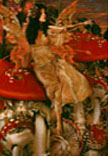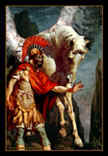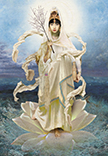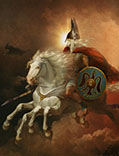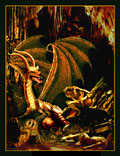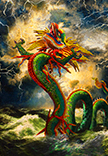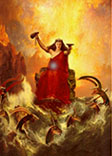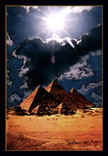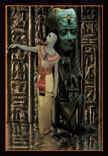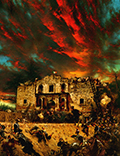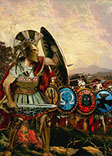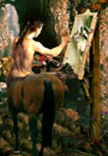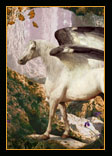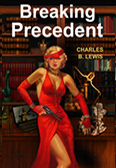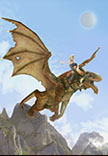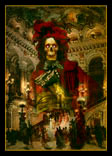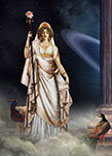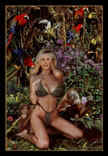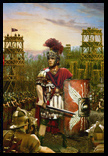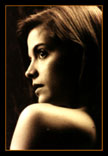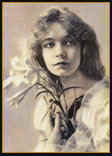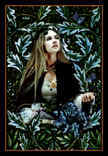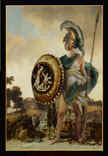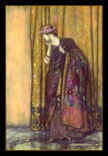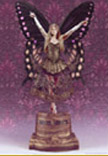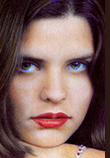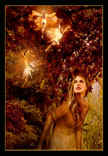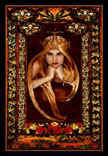|
Art,
Philosophy, and Art Philosophy: Essay 0007

On
Art and Technology: When Seeing is Not Believing
An
essay dealing with mechanical aids to visual art from Camera Obscura to
Computers
HOWARD
DAVID JOHNSON'S ESSAY ON ART AND TECHNOLOGY
Personal
Opinion Essays on HISTORY, MYTH, MORALITY,
& ART yesterday and today by the artist.
|
| Howard
David Johnson is a contemporary realistic visual artist and
photographer with a background in |
| the
natural sciences and history. He works in a wide variety of realistic
art media ranging from traditional |
| oils,
pastels and others to cutting edge digital media. He loves mixing
media. His web site features |
| many
examples of his Realistic Art, including illustration,
photography, experimentalism, and fine art. |
On Art and
Technology:
When Seeing is Not Believing
An essay
dealing with mechanical
aids to visual art from Camera Obscura to Computers
When
the
camera was finally made commercially available in the 1830's it
exploded on the world
scene and sent shockwaves through the art world as history had never
seen before. Visual
artists all over the world were suddenly put out of work and resentment
and outrage
followed. Suddenly much more realistic portraits could be had at a tiny
fraction of the
cost of a painting and delivered almost instantly. The art world would
never be the same.
When motion picture cameras were new, seeing was believing and human
consciousness changed
forever in the 20th century. Sometimes even Terror and Panic came from
the initial shock!
In 1905 cinema patrons defecated and urinated in their seats as they
broke each other's
arms and legs desperately fleeing for their lives from a crowded
theater to escape a train
charging straight for them! ... train footage filmed safely from a
bridge with a camera
lowered down on a rope. A modern cinema patron would not even feel
uncomfortable. The
Photograph and its manipulations have changed human consciousness and
history... and will
continue to do so in the future.
The Camera has
changed everything.
The
Camera of Today owes
it's origin to the Camera Obscura, a light- tight box with a lense and
a screen that
receives an image. This device has been used by artists since ancient
times to trace the
projected image of whatever they set before it on a screen. Intrigued
by the idea of
producing a permanent light-formed image instead of reproducing it by
hand, a long line of
inventors studied the problem and successively made contributions to
the solution.
Photography was neither
discovered nor invented by any one man. It was the outcome of the early
observations of
the alchemists and chemists on the action of light, a subject that
belongs strictly to the
domain of photochemistry. Although the blackening of silver salts was
known in 1565, it
was not until 1727, when Johann Heinrich Shulze of Germany used a
mixture of silver
nitrate and chalk under stenciled letters, that it was definitely
recognized that this
darkening action was caused by light and not by heat. In the years that
followed
experiments with silver nitrate on leather and wood were successful. In
1817 J. Nicephore
Niepce first tried photography with silver nitrate and paper. In 1826,
L.J.M. Daguerre, a
painter who had experimented with silver salts approached him and
formed a partnership.
Daguerre discovered
accidentally that that the effect produced by exposing an iodized
silver plate in a camera
would result in an image if the plate were fumed with mercury vapor.
The Daguerreotype
process was a complete success. These chemical processes would be
improved again and again
until the advent of the digital camera we know today. The
attitude that Photography
was not art and was a purely mechanical process requiring no talent
whatsoever was put
forth with great force and hostility in an attempt to get people to
refrain from choosing
it for their portraits instead of paintings. This is a typical reaction
to new technology,
when Pastels were first invented they were dismissed as a child’s
plaything rather
than a viable art medium. These attacks on new technology are not
limited to the arts of
course. When the Wright brothers were making history at Kitty hawk with
the first manned
airplane their detractors said: "If man were meant to fly, he'd have
been born with
wings." This kind of negativity is just human nature to some kinds of
people.
Photography
came into being through an artistic, not a scientific urge. Daguerre
was an artist, a
scene painter whose illusionistic diorama was a landmark in Paris long
before his name was
connected with photography. Critics were merciless as usual, with
scathing condemnations
of the media. However, in the hands of a sensitive artist, photography
quickly showed it's
artistic possibilities. David Octavious Hill, a Scottish Painter
invented the camera set
up and the pose as we know them today in the 1840's and was the first
of a new breed of
master photographic artists. Photography was here to stay. Diverse
forms of retouching
techniques followed both by accident and by design and took the medium
to new levels of
artistic excellence. Now, more than a century and a half later only an
uneducated or
blindly hateful person would say Photography is not an art form. Of
course we've all seen
our share of awful pictures with the heads cut off taken by amateur
photographers but
we've also seen the work of studio masters like the great portrait
photographers from
Hollywood in the 1930's and forties. Anyone who has tried to create
such a sophisticated
studio photograph realizes quickly that this is a very difficult art
form to master even
if a trained orangutan can take a bad snapshot with an instant camera
made for children.
The use of Photography as
a mechanical aid
to traditional oil paintings and other forms of realistic art came
right away. This is not
surprising since artists had been tracing from Camera Obscura for
thousands of years.
Famous Myths; Leonardo Da Vinci ( 1452-1519 ) is often credited with
the invention of
Camera Obscura because he used it for his masterworks during the
Renaissance and mentioned
it in his notebooks, but this is simply not true. Similarly, Americans
are credited with
the camera, but it is also not true. Origins: Unlike the camera, the
inventor and time of
invention of Camera Obscura are unknown. Perhaps a crude form of it was
known to the
ancient Greeks, but there is no material evidence to substantiate such
a point of view.
The mathematical precision and perfect anatomy of Greek art combined
with their passionate
love of science and mathematics is testimony enough for many scholars.
The earliest clear
description of Camera Obscura occurs in the great optical treatise of
the Islamic
scientist Al-Hazen who died at Cairo, Egypt in A.D. 1098. His Opticae
Thesaurus ( Book of
optics ) was rendered into Latin sometime during the 12th or 13th
century by an unknown
translator. Al- Hazen honestly declares that he himself did not
discover it, so we know
from this it had to have been masterminded before A.D. 1098.
| Camera
obscura is a device for tracing or sketching large objects. It consists
of a box painted black inside- a mirror at a 45 degree angle , and a
lens, like that used in a photographic camera. An image is thrown on
the mirror by the lense and reflected on the screen, where it can be
sketched with tracing paper. The Camera Obscura was in general use by
newspaper and magazine illustrators until it was replaced by the
photographic camera. Make no mistake. Professionals have been using
mechanical aids since the first caveman shaman traced his hand out on
the wall of his cave. The view finder on the reflex camera is a
development from Camera Obscura. Camera obscura, interestingly enough,
is Latin for "darkened chamber". |
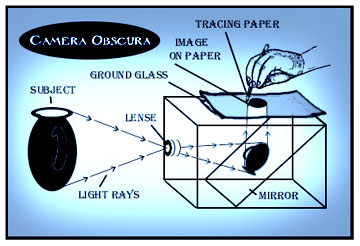
|
In
the early 1600's the telescope came into use and Camera Obscura spared
viewers the harmful
effects of gazing directly into the sun. I regret, but that we must
acknowledge the fact
that almost every art medium throughout the ages has been corrupted. In
the 2nd century,
the Roman emperor Hadrian had the head of his lunatic predecessor Nero
removed from a
statue and replaced by that of his favorite. Much later in 1539,
Holbein painted a
glamorous and flattering portrait of Anne of Cleves for Henry VIII.
When the future queen
arrived in England, King Henry met the surprisingly less than dazzling
and glamorous Anne.
His disappointment made history. Our modern society certainly can't
claim t he honor nor
take the blame of being the first to manipulate art forms.
By the 21st century instead of the traditional assistants and
apprentices, artists
employed overhead transparency projectors, opaque projectors,
artographs, light tables,
slide projectors, color photocopying... and suddenly, computers and
image editing
software, which brings us to some very compelling controversies
regarding these modern
imaging technologies and their impact on various media and further
changes to human
consciousness. For example: The integrity of Photography as evidence in
our courts of law
stood for many decades until it was shattered by the digital
manipulation of photographs
and new standards needed to be introduced. Websites sold peeks at
photos of
celebrities' heads pasted onto photos of wild women in scandalous poses
for all the world
to see- but advertised as real celebrity pix. Scandal rocked television
and other news
media when digitally altered photographs were being passed off as
reliable evidence of
important news stories...
On a positive
note, no one was threatened by how this technology enabled motion
pictures to do epic
things they could only dream of before. They were supposed to be
make-believe images
appearing real! A golden era in special effects cinema ensued. Then,
this powerful digital
imaging technology, like the camera, fell into the hands of the common
man through
computer programs like Adobe Photoshop. A new culture of skepticism had
abandoned the age
old adage; "seeing is believing" Photography has never told the whole
truth,
just parts of it. Photography is also an art form and therefore
rightfully susceptible to
creative alterations. In addition, the advancement of digital
manipulation technology
cannot be undone or halted. I believe that we must recognize that this
digital technology
exists on a gigantic-scale, and will never go away. Therefore, I
suggest that digitally
altered photos are distinct from traditional photography, and should be
treated as such.
Contrasting views:
anti-manipulation
advocates’ fear a negative impact of digital manipulation in a court of
law, and
pro-manipulation advocates say that we must wake up to the fact that
for for decades
pictures have not been reliable evidence in court and that any good
lawyer will attempt to
discredit photographic evidence. In response to claims that photos
should always tell the
truth, the pro-manipulation camp would say that photos have never told
the unvarnished
truth. A camera shows, and has always only shown, a fraction of
reality, and even then
what we see is taken out of context or even fabricated. Photography
from its onset has
been subjected to modifications. In 1839, the Frenchman Louis-Jacques
Daguerre patented
the daguerreotype, or what could be called the first "picture." Simply
explained, the daguerreotype combined the usage of the camera obscura
and silver iodide to
produce a permanent image on a copper plate. A very exciting
innovation, Daguerre boasted
of it, "With this technique, without any knowledge of chemistry or
physics, one will
be able to make in a few minutes the most detailed views"
("Photography").
Almost immediately, the daguerreotype, especially daguerreotype
portraits, became
immensely popular. Its popularity, of course, can be attributed to its
novelty, but also
because people believed the daguerreotype produced a more real image
than a painting. The
general attitude toward the daguerreotype was that it could create
images more
realistically because there was no artist to interpret and modify it in
his own style.
Opponents
of Digital Manipulation insist Photography should always represent the
truth, asserting
Photography's first and foremost function is to portray reality.
Many assume that
photographs have never been manipulated, and that this recent outbreak
in digital
technology damages the integrity of photography. Without delay,
anti-manipulation
proponents demanded an end to all "dishonest" photography, as it
severely
misleads the public. Also, they view digital manipulation as a purely
mechanical process,
with no talent or skill involved. Furthermore, anti-manipulation
proponents fear
manipulated photos might acquit murderers or rapists in courts of law.
The thought that
photography had replaced painting abounded. "As if photography needed
to absolve
itself from its ‘original sin’--of having brought about the death of
painting", a movement known as pictorialism thrived around 1890-1914,
the Art Nouveau
period. Proponents of pictorialism primarily set out to gain the
recognition of
photography as an art rather than just a mechanical process. The
pictorialists fashioned
bizarre and oddly focused images in order to prove photography was
indeed a creative art.
It was here that such concepts as shading and enhancing during
development appeared.
Because of these new shadings and angles, it can be said that Art
Nouveau saw the dawn of
"Photo manipulation." So the manipulation of photography actually began
early in
the the 20th century.
In
1982 there was outrage over the manipulation of the Great Pyramids on
the cover of
National Geographic but the Genie was out of the bottle. There was no
going back. In the
1990’s Computer programs like Adobe Photoshop began to be available to
the general
public. Now, even someone with little or no talent could produce
delightful works. On the
other hand, sensitive artists could produce masterpieces on a scale
undreamed of. It seems
clear that using this technology to willfully falsify photographs for
slanderous,
scandalous, or persuasive ends is morally wrong, but what about using
it to create obvious
unreality that looks real or Fantastical Realism in art as in pictures
of fairies or
mythic creatures?
What is realism? Realism
in Art and
literature has always meant that the artist attempts to represent
persons, scenes, things,
and facts as they are, life as it is. The word is used in many senses-
as opposed to
romanticism, to conventionalism, to sentimentalism, to idealism and to
imaginative
treatment. Sometimes it is a term of praise, and sometimes it is a term
of derision.
During the 19th and 20th centuries the use of the word realism often
implied that the
details brought out were of an unpleasant, sordid, obscene, or
generally offensive
character. Even the greatest illustrators of the day were ridiculed.
Realism is commonly
applied to a 19th century school of writers and artists; but realism,
in it's prime and
proper sense, is as old as art and literature themselves, but in the
hands of it's most
notorious exponents, it quickly degenerated into a connotation of the
more sinister
features of realism.
Many 20th century contemporary realists and artists working in the
Photo Realism style
were trained in an educational system openly hostile or dismissive to
Classical realism
and art tradition and were only taught the tenets of Abstraction and
Expressionism. As a
result many of these artists are more akin to the abstract and
expressionist schools than
the "Classical Realism" of the ancient Greeks, which adored beauty and
nature.
Contemporary Realism does not embrace the math and design of the
Classical school but does
not frown on beauty. Photo Realism only strives to look as much like a
photograph as
possible and sometimes the results are shocking or disturbing. Other
times they are
mundane and so ordinary as to be boring. They often deliberately
decline to select
subjects from the natural, beautiful, and harmonious and more
especially, depict ugly
things and bring out details of an unsavory sort for social and
political purposes. The
real mission of Photo-realism is not to record everyday life like a
Norman Rockwell
painting, but to expose the unconscious way we look at and accept
photographs.
By the 20th century
realism had spread to
nearly all nations- realistic elements combined with those of
Impressionism, Symbolism,
and other movements. Fantastic Realism on the other hand, is born of
these movements and
tied to them in style and technique, but prefers to explore subjects
that are strange or
strikingly unusual rather than scenes of everyday life or objects. It
is often bizarre in
form, conception and appearance and even wondrous in its beauty.
Sometimes macabre and
grotesque, it is rarely boring like the other forms of Realism in
visual art so often are.
Fantastic Realism can be completely apart from reality, yet appearing
to be quite real. It
is versatile in that it can combine with or be a part of the Classical,
Contemporary or
Photo-realistic schools or stand as a style unique unto itself. I
combine elements from
all of these schools of Realism and then take it a step further by also
combining a wide
variety of media from traditional oil paintings to today's cutting edge
digital media in
my exhibits. Naturally, the darker side human nature shows itself again
with condemnation
of new schools of expression, and new art media and technology. Like
the photographers
before them, digital artists wanted the recognition of their work as an
art rather than
just a mechanical process. Unlike the snapshot camera or an abstract
painting, a trained
chimp or orangutan cannot do it: it takes the same visionary and eye to
hand skills as any
traditional art media to do it well
Since the
times of the ancient
Greeks, Art History records a relentless quest for Realism and artistic
excellence. The
masters of each generation strove to perfect their craft, then passed
on the torch of
their accumulated knowledge and skill to the next generation.
The accomplishments and
technological
breakthroughs of one generation have often set new standards of
excellence for the next.
~ Howard David
Johnson
*****
( These essays are never
meant to offend, but
to spur thought and democratic debate in a spirit of fun. )
|
The
Johnson Galleries
Click
on the Icons to visit the Thematic Galleries of Realistic Art:
Including Mythology of Greece, Rome, Asia, The Norsemen, and
more...Fairy and Dragon legends, The King Arthur Legends, The Seven
Wonders of the Ancient World, Paintings of Ancient Egypt and Babylon,
Ancient Mystic Religious texts, History of War from The Ancient
Spartans and the Trojan Horse to World War Two, The World's Great
Religions, and Art Technique and design...Art Lessons, Celtic Mythology
& Pencil Techniques display some full size art...
|
|
ABOUT THE
ARTIST
The various galleries linked
to by the thumbnail icons in his web show many examples of HDJ's
Realistic Art, and are grouped by theme rather than media. There are
also sample illustrations from his upcoming books on Celtic Myth
and Legend and World Myth & Legend. Since boyhood he has
passionately copied the old masters. To create his work, he usually
starts with a thematic concept followed by a rough realistic
pencil sketch, then followed by his photography, often traveling to
find suitable scenes and locations and then working in his Photography
studio with live models from his sketches. He then assembles a variety
of elements which are realistic and original. As a boy he
dedicated his life to art in 1960. From 1965- 1999 he used xeroxes and
tracings to make his preliminary photo montages. This is patterned
after the manner used by Maxfield Parrish and other 19th century
notables. Beginning with a tracing, he then draws or paints from these
complex original Computer Photo Montages. Many of these are on display
on this web and slated for future completion in a variety of
traditional realistic art media. As this happens, the finished
work is substituted in the exhibit.
|
| He
has built up an enormous library of original source photos to use in
his realistic art. Recently he shot hundreds of aerial photos of
clouds at marvelous angles and perspectives and also looking down on
the mighty mountains, rivers, and deserts of the American west while
flying from Texas to Oregon and back for dynamic source material for
realistic flying scenes in upcoming paintings, drawings, and
pictures. For decades he has sought out the most beautiful models
and brought them in for sessions in his photography studio. Using a
strategy employed by J.W. Waterhouse, the old master HDJ imitates most-
see Helen of Troy ( a recognizable tribute ) and The Messenger ( in the
spirit of Waterhouse ) both featuring Grace- his wistful and graceful
models cannot be underestimated in their contribution to the stunning
beauty and the potential for lasting appeal of his work. Their last
names are withheld to protect them from stalkers & other internet
predators.
His favorite
medium for traditional realistic art is colored pencil because of the
high speed and low expense, and people began expressing difficulty in
telling his colored pencil drawing from photographs in the early
1980's. In the last 35 plus years he has also mastered Oils,
Pastels, Acrylics, Watercolors, Inks, Scratchboard, Gouache,
Photography, and most recently, the highly controversial
digital media. As a commercial illustrator Johnson has
not only used the computer to create art but has been involved in the
development and marketing of computer imaging software for Adobe
Photoshop. Working in a realistic style inspired by classic
illustrators HDJ is deeply rooted and grounded in the Greco-Roman
artistic tradition, Feeling that especially with realistic art -
that the human form is the ultimate arena for artistic
expression. His lifelong dream came true when his Traditional Realistic
Art was exhibited in the British Museum in London England in 1996. His
mixed media has also been displayed in numerous other ones since
such as the Metropolitan Museum of Art. Having achieved international
acclaim as a traditional visual artist he discovered digital media in
1999. Because of his passion for realistic art and photography he
elected to embrace it and joyfully be a part of this historic era in
the visual arts as a 21st century realistic artist.
Computers
have not diminished his love of working in traditional media. He loves
to draw portraits from his own photographs as well as using them to
create illustrations in various media. Click on 'The Messenger'
above for more on HDJ's other public domain sources & influences he
uses to create his realistic art.
Since
1972 when he began his career as a scientific illustrator for the
University of Texas he has earned his living illustrating all kinds of
books, magazines, CD covers, and all sorts of games, greeting cards,
calendars, portraits, murals and the like with his contemporary
realistic art... HDJ's Realistic Art has appeared in every major
bookstore chain and fantasy gaming shop in The United States and has
been used in educational texts and magazines all over the world. This
site features realistic paintings & pictures for the twenty-first
Century including some oil paintings, as well as lots of
other exciting realistic art media such as colored pencil drawings,
pastel paintings, acrylic paintings, gouache paintings, water color
paintings, and pencil drawings, and also featuring studio, field,
& aerial photography, digital painting and photo-montage and
all these media mixed in an assortment of experimental
combinations...Working in a wide variety of media to create his
realistic art he offers his customers a host of payment and product
options. He delivers the rights to these custom made copyright free
realistic illustrations and old fashioned customer service when he does
work-for-hire.
|
|
*****

|
|
| Howard
David Johnson is a contemporary realistic visual artist and
photographer with a background in |
| the
natural sciences and history. He works in a wide variety of realistic
art media ranging from traditional |
| oils,
pastels and others to cutting edge digital media. He loves mixing
media. His web site features |
| many
examples of his Realistic Art, including illustration,
photography, experimentalism, and fine art |
He accepts
select
commissions to paint custom oil paintings with down payments starting
at only one thousand
dollars. Other media, like colored pencils or digital are of course far
less expensive. He
grants permission for most educational purposes simply for asking
courteously. To use his
existing realistic art he offers licenses for publishing starting as
low as $100.00 USD
NEW REPRINTS! LICENSES CUSTOM BOOK COVERS
ORIGINAL ART ART INSTRUCTION ART
BOOKS
info@howarddavidjohnson.com
Your
business,
letters, & links are always welcome.
*****
Thank
you for Visiting...


